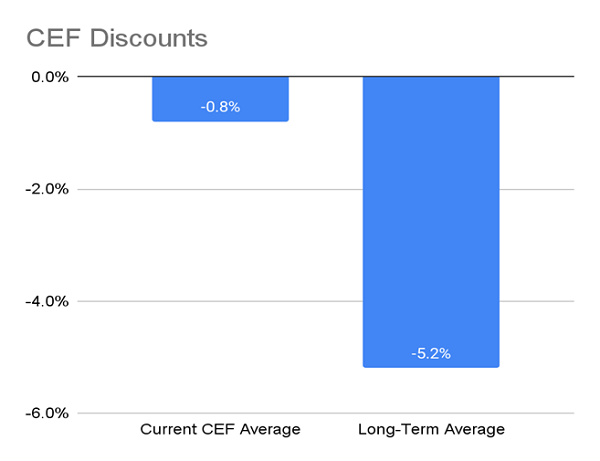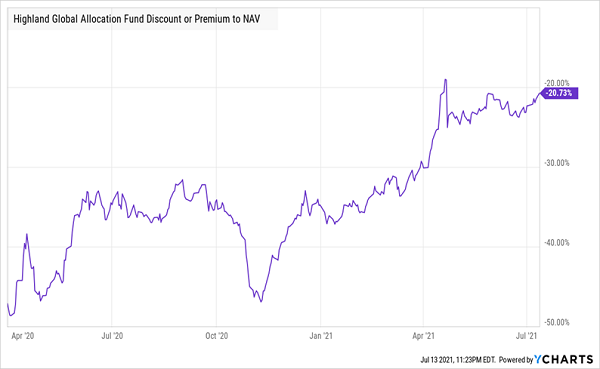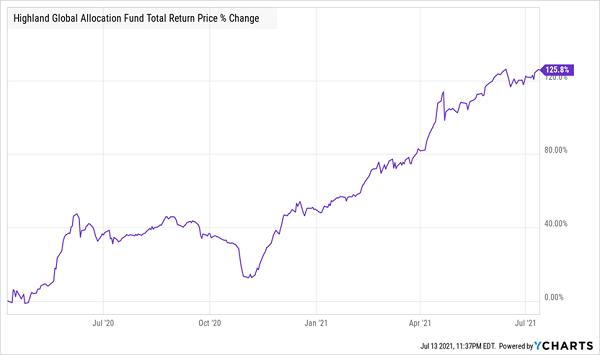One of the so-called “rules” of income investing is that you can get a high dividend or a sustainable dividend from a stock or fund—but not both.
And to be fair, that is true of some investments. But there are plenty of exceptions, too, chief among them an asset class that sports a little-known “trick” that gives us blockbuster 9% dividends that are more than sustainable over the long run.
The CEF Secret
That asset class would be closed-end funds (CEFs), and the “trick” ties into the fund’s discount to net asset value (NAV, or the value of the investments in the fund’s portfolio).
Don’t get hung up on the jargon here—the discount to NAV simply refers to a CEF’s unique ability to trade below the per-share value of its portfolio. The upshot is that when a CEF trades at a discount, the yield we get (which is based on the market price) is higher than the yield on NAV—or what management must earn to cover that yield.
The result is a kind of best-of-both-worlds scenario when it comes to dividend safety.
I know this may still sound a bit murky, so let’s take a closer look at how a CEF’s discount makes its yield more sustainable. Then we’ll see how this potent dynamic plays out with a specific CEF that hands investors a sky-high 9.3% dividend today.

Source: CEF Insider
Let’s start with the state of play in CEF-land when it comes to discounts.
Over the long-term (or over the last 10 years or since the fund’s IPO, whichever is soonest), CEFs have had an average 5.2% discount to NAV. However, a red-hot stock market means the current average discount has shrunk to the smallest amount ever tracked by my CEF Insider service—just 0.8%!
Don’t despair, though; although CEF discounts are small on average, that’s due to some funds seeing a lot of bidding, resulting in high premiums and skewing the average. Several good CEFs still sell at discounts.
Now let’s look at exactly how these discounts make our dividends more sustainable. For that, we’ll use the example of the Highland Global Allocation Fund (HGLB), a small fund of about $210 million in assets under management with investments around the world (half in America) and a mix of real estate, stocks and bonds. HGLB’s goal is to diversify across asset classes to get investors a good mix of assets and a strong income stream at the same time.
HGLB yields 9.3% as I write this, much more than the 6.1% for the average CEF (and, of course, much higher still than the measly 1.3% yield you’d get from the average S&P 500 stock).

Source: CEF Insider
Alarm bells ringing in your head yet? A 9.3% yield sounds dangerously high, and in some cases it can be. But HGLB has a big discount working in its favor here.
In fact, HGLB trades at one of the highest discounts of any CEF on the market, with a whopping 20.7% discount to NAV. And that discount is narrowing. It was actually twice as big a year ago.
A Huge, but Fading, Discount

CEFs trade at discounts when investors bid less for a fund than what it’s actually worth. This can happen for a variety of reasons, but it’s usually a mix of a lot of risk-averse investors scared of a market pullback (which, ironically, means CEF discounts tend to be widest after a crash and smallest after a boom) and the general obscurity of the CEF market (few CEFs have market caps over $1 billion, while the biggest ETFs have market caps in the hundreds of billions).
In any event, when a fund’s discount shrinks, its market price goes up, giving investors who bought at the wider discount a strong return. And HGLB investors have been getting that.
Huge Gains for HGLB Investors

This 125% return (in gains and dividends) in a little over a year is great, but it’s not the best thing about HGLB. What’s really compelling is that the fund’s big discount today means its 9.3% dividend, paid out to investors on a market-price basis, is actually just 7.3% for the fund managers.

The reason for this is simple: the fund earns a return on its NAV, not on its market price, which means it pays out its dividend from NAV profits. And when discounts are big, the NAV profits management needs to maintain the dividend are smaller. The smaller the discount, the smaller the gap between the yield the fund has to pay out and the return it needs to maintain that payout.
In the case of a big premium, this could spell bad news. A 20% premium would mean HGLB would have to earn an 11.2% annualized return to sustain its payouts! But with that same amount as a discount, it only needs to earn 7.3%.
And a 7.3% return is less than the annualized return we’ve seen for stocks (15%) and real estate (8.6%) over the last decade. Thus, while we’re getting an above-market yield, thanks to the magic of CEF discounts, the fund only needs to get the market’s return for its payouts to be sustainable.
This trick doesn’t just work for HGLB. There are literally hundreds of CEFs that can use their discounts to deliver big and sustainable dividends.
The 5 Best CEFs to Buy for Safe 6.9% Dividends and Upside
CEFs also boast another level of safety almost no one knows about.
Get this: of the CEFs that have been around for a decade or more, fully 96% have made money in the last 10 years. And when you strip out the CEFs in the volatile energy sector, that number jumps to an amazing 99%!
That’s as close to a no-lose investment as you can get! And due to CEFs’ massive yields, you’ll be collecting most of your return in dividend cash, too.
Right now, I’m sharing my top 5 CEFs with the public, and I want you to start collecting their massive payouts now (I’m talking a 6.9% average dividend here) and get in position for big price upside, too. My latest forecasts call for 20%+ price gains from these funds in the next 12 months!

Recent Comments